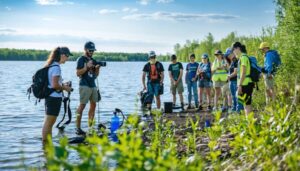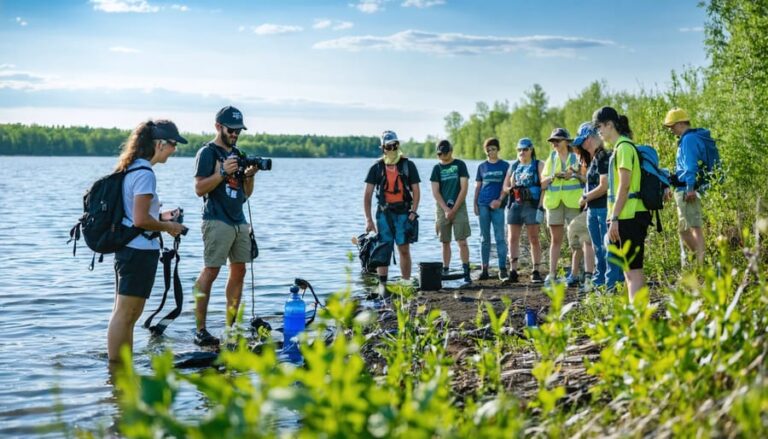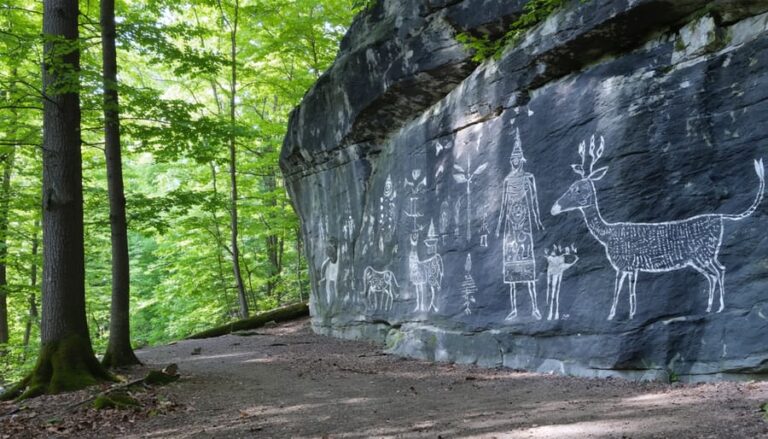Stand at the edge of Petroglyphs Provincial Park’s ancient rocks, where centuries of Indigenous spiritual practices whisper through the Canadian Shield. Sacred journeys aren’t just physical travels through Ontario’s landscape – they’re transformative experiences that connect us to something far greater than ourselves. Whether following the well-worn paths of the Bruce Trail’s spiritual sites or seeking solitude among the towering white pines of Temagami’s old-growth forests, these sacred spaces offer modern pilgrims a chance to reconnect with both nature and spirit.
For generations, Indigenous peoples have honored these lands through ceremony, vision quests, and sacred rituals. Today, those seeking their own spiritual connection can respectfully explore these powerful places, carrying forward ancient traditions while creating new meanings. From the mist-shrouded cliffs of the Niagara Escarpment to the remote islands of Lake Superior, Ontario’s sacred sites remind us that every mindful step on these ancient grounds is part of humanity’s ongoing quest for meaning, healing, and connection to the land.
Remember: these aren’t tourist attractions, but living spiritual sites deserving of profound respect. Each journey here is an opportunity to practice gratitude, walk gently, and open our hearts to the wisdom these sacred places have shared across millennia.
Indigenous Sacred Sites: Walking Ancient Paths
Petroglyphs Provincial Park
Nestled in the heart of Ontario, Petroglyphs Provincial Park houses the largest known concentration of Indigenous rock carvings in Canada, making it a profound destination for those seeking to connect with Indigenous cultural heritage. Known as “The Teaching Rocks” or “Kinomagewapkong” in Ojibwe, these ancient petroglyphs feature over 900 symbolic carvings depicting turtles, snakes, birds, and human figures.
Created between 900 and 1400 CE, these sacred carvings are etched into crystalline limestone, telling stories of dreams, shamanic journeys, and spiritual teachings. The site remains deeply significant to Anishinaabe peoples, who consider it a place where the spirit world connects with our own.
Visitors can explore the petroglyphs from a specially designed viewing area within a glass-enclosed building, which protects these precious carvings from the elements while allowing for detailed observation. The Learning Place Visitor Centre offers interactive exhibits and cultural programming that helps guests understand the profound spiritual significance of the site.
Remember to approach this sacred space with respect and reverence. Photography isn’t permitted inside the petroglyph site, encouraging visitors to be present in the moment and truly absorb the spiritual energy of this remarkable place. Consider visiting during quieter morning hours when the park first opens for a more contemplative experience.

Manitoulin Island’s Spirit Sites
Manitoulin Island, the largest freshwater island in the world, holds deep spiritual significance for Indigenous peoples, particularly the Anishinaabe. The island’s name itself means “Spirit Island” in Ojibwe, reflecting its sacred character and ancestral importance.
Throughout the island, you’ll discover numerous sacred sites that have been spiritual gathering places for generations. The Cup and Saucer Trail, while famous for its stunning views, is also home to several traditional ceremonial grounds. Remember to stay on marked paths and avoid disturbing any offerings or sacred items you might encounter.
The Manitoulin Island powwow grounds, particularly those in M’Chigeeng and Wikwemikong, are vital spiritual spaces where traditional ceremonies and gatherings take place. If you’re fortunate enough to attend a powwow, follow local protocols and always ask permission before taking photos.
Near Providence Bay, ancient pictographs tell stories of spiritual journeys and teachings. These delicate rock paintings require our protection – admire them from a respectful distance and never touch the surfaces.
Insider tip: Before visiting any sacred sites, connect with local Indigenous tourism organizations or cultural centers. They can provide guidance on proper protocols and sometimes offer guided experiences with knowledge keepers who share stories and teachings about these special places.
Remember, these aren’t just tourist attractions – they’re living spiritual sites deserving of our utmost respect and care.
Natural Sanctuaries: Places of Peace and Reflection
The Grotto at Bruce Peninsula
Among the most captivating natural wonders of Ontario, The Grotto at Bruce Peninsula stands as a testament to nature’s artistic prowess and spiritual energy. This limestone cave, carved by the relentless waves of Georgian Bay over thousands of years, creates an almost cathedral-like atmosphere that draws visitors into a state of peaceful contemplation.
The ethereal turquoise waters that pool within the grotto’s chamber seem to glow from within, creating an otherworldly ambiance that has inspired meditation and spiritual reflection for generations. Indigenous peoples have long recognized this site as a place of power, where the boundaries between the physical and spiritual worlds feel remarkably thin.
Visitors often describe feeling a profound sense of connection to nature while sitting in quiet reflection within the grotto’s cool embrace. The interplay of light and shadow through the cave’s natural skylight creates ever-changing patterns that dance across the ancient rock walls, adding to the site’s mystical appeal.
To fully appreciate the grotto’s spiritual essence, consider visiting during sunrise or sunset when fewer crowds are present. Remember to approach this sacred space with reverence – speak softly, avoid disturbing the natural environment, and take a moment to simply be present in this remarkable sanctuary where earth and water meet in perfect harmony.

Thousand Islands’ Sacred Islands
Nestled among the sparkling waters of the St. Lawrence River, the Thousand Islands region harbors several islands that have held deep spiritual significance for generations. The Mohawk and Haudenosaunee peoples have long considered these islands sacred grounds, using them for ceremonies and spiritual gatherings that continue to this day.
Endymion Island, with its ancient white pines and quiet coves, served as a traditional meeting place for Indigenous spiritual leaders. Local elders speak of the island’s unique energy, describing it as a place where the veil between the physical and spiritual worlds feels particularly thin.
Mermaid Island, despite its whimsical name, holds profound cultural significance. Archaeological evidence suggests it was once used for vision quests and coming-of-age ceremonies. The island’s distinctive rock formations still draw visitors seeking moments of reflection and connection with the past.
When visiting these sacred spaces, it’s essential to practice respectful tourism. Stay on marked trails, avoid disturbing any ceremonial sites, and never remove artifacts or natural objects. Consider joining a guided tour led by Indigenous knowledge keepers to learn about these islands’ spiritual significance firsthand.
The best times to visit are during sunrise or sunset when the islands are bathed in golden light and the waters are typically calm. Remember to bring an offering of tobacco, as is customary in Haudenosaunee tradition when seeking to experience these sacred places.
Respectful Visitation: Honoring Sacred Spaces

Cultural Protocols
When visiting sacred sites in Ontario, it’s essential to approach these spaces with reverence and respect. Always check if permission is required before visiting, as some sites may have specific visiting hours or ceremonial schedules. Keep your voice low and avoid loud conversations or music that might disturb others seeking spiritual connection.
Photography protocols vary by location – some sites prohibit photos entirely, while others allow them with permission. When in doubt, ask local guides or site stewards about appropriate practices. Never remove anything from these sites, including rocks, plants, or ceremonial items, as they hold deep spiritual significance.
Dress modestly and appropriately for the setting. Some locations may require specific attire or head coverings. Consider bringing a small offering of tobacco, which is customary in many Indigenous traditions, but always confirm local protocols first.
Stay on marked paths to protect the natural environment and archaeological features. If you encounter ongoing ceremonies or private gatherings, maintain a respectful distance unless invited to participate. Remember that these aren’t tourist attractions, but living spiritual spaces that continue to hold deep meaning for many communities.
Conservation Guidelines
When visiting sacred sites, it’s essential to practice responsible tourism to preserve these special places for future generations. Always stay on marked trails and viewing areas to prevent erosion and protect delicate ecosystems. Remember the cardinal rule: take only photographs, leave only footprints.
Before your visit, research the cultural significance of the site and any specific protocols or customs you should observe. Many Indigenous sacred sites have traditional guidelines that visitors should respect, such as avoiding certain areas during ceremonies or refraining from touching sacred objects.
Pack out what you pack in, and consider bringing an extra bag to collect any litter you find along the way. Minimize your impact by keeping groups small and speaking in hushed tones to maintain the peaceful atmosphere these places deserve.
If you’re planning to take photographs, check if photography is permitted. Some locations may have restrictions, particularly during ceremonies or at specific sacred features. When allowed, avoid using flash photography, which can damage ancient pictographs and petroglyphs.
Support local conservation efforts by making donations when possible or joining volunteer programs that help maintain these precious sites. By being mindful visitors today, we ensure these sacred journeys remain meaningful experiences for generations to come.
Sacred journeys in Ontario’s parks offer more than just scenic views – they provide windows into ancient wisdom and spiritual connections that have existed for thousands of years. As we explore these special places, it’s crucial to remember that they remain deeply meaningful to Indigenous communities today. By following proper protocols, staying on marked trails, and learning about the cultural significance of these sites before visiting, we help preserve them for future generations. Consider joining guided Indigenous experiences when available, as these provide authentic insights while supporting local communities. Remember that each sacred site tells a unique story of our shared heritage, and approaching these spaces with respect and mindfulness enriches not only our own journey but honors the continuing spiritual traditions of Ontario’s First Nations peoples.














+ There are no comments
Add yours